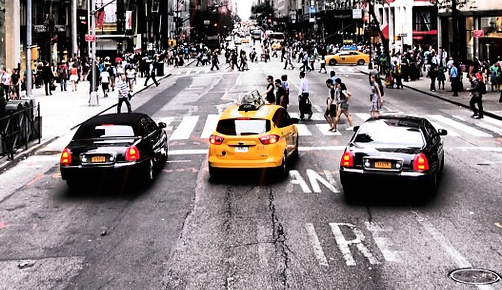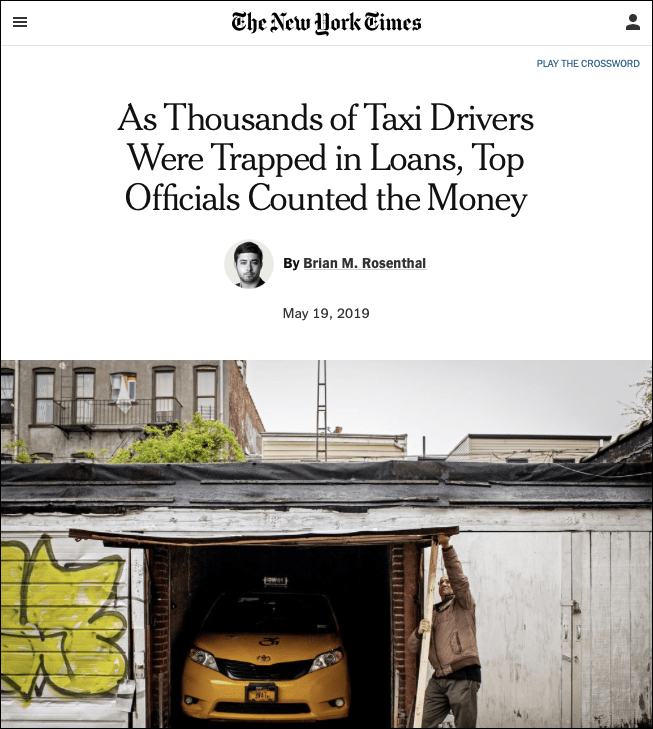Komanoff: Times Exposé Understated the Damage to Yellow Cab Industry by Uber and Lyft
2:23 PM EDT on May 30, 2019

Ubers and yellows appear to be banished under the NYPD order. Photo: Max Pixel
The New York Times's exhaustive series about the horrifying financial plight of yellow taxicab drivers may actually have understated the fiscal crisis — and, in doing so, let Uber and Lyft off the hook, a cab industry expert told Streetsblog.
In the Times series (part 1 and part 2), writer Brian Rosenthal reported, "since Uber entered New York in 2011, yellow cab revenue has decreased by about 10 percent per cab, a significant bite for low-earning drivers but a small drop compared with medallion values, which initially rose and then fell by 90 percent." But taxi industry expert Charles Komanoff, a frequent Streetsblog contributor, said the drop in revenues is actually 36 percent.
This is not to say that the Times report on the larger issue of medallion values is inaccurate — but simply that Rosenthal's 10 percent figure understates the disastrous role Uber and Lyft have had in undermining cab drivers' income.
"The difference between a 10-percent taxicab revenue decrease and a 36-percent taxicab revenue decrease is extremely consequential," Komanoff wrote in a letter to Rosenthal (shared with Streetsblog) shortly after publication of his stories on May 19-20. "The lower figure could be consistent with a narrative that largely attributes the extreme financial distress of yellow cab drivers and medallion owners to the predatory lending you described."
But in lowballing the drop in revenue, Komanoff continued, Rosenthal missed "a broader narrative that places the cannibalization of the taxi industry by Uber and Lyft as a destructive force that has been every bit as impactful as the predatory lending depicted in your series."
Here's how Komanoff crunched the numbers — and what Rosenthal may have failed to consider.
Since 2011, cab drivers have been forced to collect two surcharges on fares: a 30-cent "taxicab improvement fund" (TIF) surcharge on all fares that went into effect in 2015, and the more recent $2.50 "congestion" surcharge that took effect in early February after several rounds of court battles and is now collected on an estimated 90 percent of yellow cab trips.
Those surcharges are collected by yellow cabbies and are included in the Taxi & Limousine Commission’s farebox figures. But they aren't revenue for them, as the TIF money goes to the city and the congestion surcharge money is passed to the state.
Rosenthal and Komanoff agree that in March, 2011, daily farebox revenue for yellow cabbies was $5,717,207. And both agree that by March, 2019, that number had dropped to $4,289,036.
But Rosenthal didn't remove the surcharges from the farebox revenue for March, 2019. Had he done so, Komanoff wrote, he would have realized that cabbies had only made $3,644,820 in actual revenue — not just what the farebox recorded, but what they actually could put in their pocket. That figure is 36.2 percent less than yellow cabbies' daily take in 2011.
And that doesn't even take into account inflation, which has cut the value of a 2011 dollar by 12.5 percent. When that decline is factored in, “real” revenues across the entire yellow taxi industry have dropped 44 percent since Uber and Lyft showed up.
To be fair, Rosenthal's piece had some wiggle room, as he reported that revenues had dropped by about 10 percent "per cab." Indeed, in March, 2011, there were 12,852 yellow cabs picking up fares. By March, 2019, that number had dropped to 10,814. If you cut the numbers the way Rosenthal did, you come up with a revenue drop of roughly 10 percent per cab. (Though even under that scenario, he should have removed the surcharges, which would have yielded a 24-percent per cab revenue drop.)
In any event, Komanoff argues against a per-cab methodology for one simple reason: It again reduces the impact of Uber and Lyft, which caused more and more yellow cabbies to simply give up. (And, lest we forget, Uber and Lyft also add to congestion.)
"There is no starker evidence of this devastation [of the finances of yellow cabbies] than the withdrawal from daily service of some 2,000 taxicabs," said Komanoff, who has consulted for the medallion industry, but is not currently. "To calculate per-taxicab revenue without those mothballed taxicabs ... is to whitewash this destruction. That would be akin to measuring the effect of famine on a herd of livestock by measuring weight loss only among the survivors while ignoring the sizeable fraction — 16 percent in this case — of those who perished."
But Rosenthal disagrees. The reporter told Streetsblog that he will soon publish a reply of sorts on the revenue reduction, but was eager to share a preview with Streetsblog readers.
"Our feeling on this is simple: A cab that is not on the road does not make any money, just like a hot dog vendor who is home sick does not make any money," he said. "Taxi industry leaders say that Uber/Lyft is to blame for those cabs being off the road, but we found, through months of painstaking research, including interviews with 450 people and an analysis of thousands of documents, that is simply not true. At least 950 medallion owners have gone bankrupt because their lenders have come after them, and their cabs are now off the road, not making any money."
And Rosenthal concluded with a larger point:
"Whether the [revenue decline] number is 10 percent, or 15 percent, it does not change that the taxi medallion market was inflated, exploitative, unstable and unsustainable long before Uber arrived," he said. "Ride-hailing may very well have been what tipped it over. But it was clearly ready to burst before that."
But getting the figures right is crucial, Komanoff told Streetsblog, because the legislature has directed the new MTA congestion pricing board to review the congestion surcharges for taxicabs and app-based vehicles.
“If not just predatory lending, but predatory competition from the app-based companies has decimated the yellow cab sector, the panel can set things right by revising the surcharges to include additional levies on the time that Ubers and Lyfts spend trawling for fares in Manhattan,” Komanoff said.
Charles Komanoff Letter to Brian Rosenthal - May 22, 2019 by Gersh Kuntzman on Scribd
Gersh Kuntzman is editor in chief of Streetsblog NYC and Streetsblog USA. He also writes the Cycle of Rage column, which is archived here.
Read More:
Stay in touch
Sign up for our free newsletter
More from Streetsblog New York City
Thursday’s Headlines: Speed-Limiting Tech Edition
State Sen. Andrew Gounardes continues his push to force reckless drivers to install speed limiters in their cars. Plus more news.
DOT Official: All Our Free Parking Justifies Keeping Curb Space for EVs
If only someone could do something about the parking!
New York City to Install 500 Secure Bike Parking Hubs In The Next Five Years: Sources
Your bike may finally get a roof over its head.
Adams Backs Lower Speed Limits, Calls Crashes ‘Accidents’
The mayor wants New York City drivers to "slow down," but it's not clear yet how many streets will get lower speed limits.
Wednesday’s Headlines: Trump Posts About Congestion Pricing Edition
Donald Trump comments on congestion pricing — no surprise, he's against it. Plus more news.





